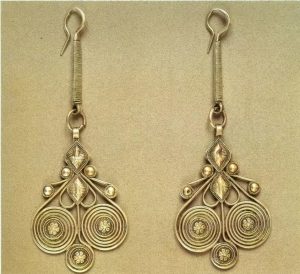




Temporal pendants are, as archaeology testifies, one of the oldest types of women’s jewellery, which were common in different variations throughout Eurasia. They could be made of metal, beads and their combinations. Kazakh temple jewellery “shekelik” is a vertically elongated product consisting of several parts. Shekelik comes in the form of triangles, diamonds, hearts, petals and other plates that form a chain connection. They are attached to a headdress or to a girl’s hair.
In most cases, the temple jewellery is part of the wedding set. Some experts believe that the temple jewellery duplicates the protective function of earrings. For example, the khakass temple jewellery consisted of coral beads, silver coins and was decorated with silk tassels. According to the belief of the ancient Turks, the coral beads were the place where the goddess Umay kept the souls of the children’s embryos. This explains why they are so numerous in the decor of the Karakalpak and Kazakh saukele. The shape of the Turkic temple ornaments, a vertical line, apparently projects the concept of the world tree, which eternally bears fruit and blooms. And temples (Kazakh sheke ) were considered an extremely vulnerable area in popular culture, so their decoration and guarding were treated with special reverence. The sacral significance of the temple bones in general, says the Kazakh tradition “shekege shaqyru”, the essence of which is to treat elders, usually parents of the same age, and receive their blessings. The obligatory element of such treatment is the head of a horse or a cow, half of it without the nose part. The sheke beru is considered an expression of the cult to worship the ancestral spirits (aruakhs).


